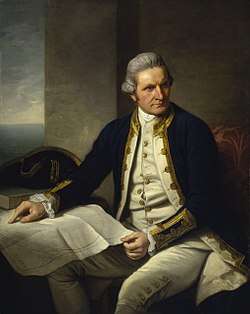First voyage of James Cook
The first voyage of James Cook was a combined Royal Navy and Royal Society expedition to the south Pacific Ocean aboard HMS Endeavour, from 1768 to 1771. It was the first of three Pacific voyages of which James Cook was the commander. The aims of this first expedition were to observe the 1769 transit of Venus across the Sun (3–4 of June that year), and to seek evidence of the postulated Terra Australis Incognita or "undiscovered southern land".
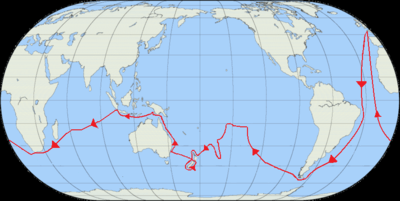
The voyage was commissioned by King George III and commanded by Lieutenant Cook, a junior naval officer with good skills in cartography and mathematics. Departing from Plymouth Dockyard in August 1768, the expedition crossed the Atlantic, rounded Cape Horn and reached Tahiti in time to observe the transit of Venus. Cook then set sail into the largely uncharted ocean to the south, stopping at the Pacific islands of Huahine, Borabora and Raiatea to claim them for Great Britain, and unsuccessfully attempting to land at Rurutu. In September 1769 the expedition reached New Zealand, being the second Europeans to visit there, following the first European discovery by Abel Tasman 127 years earlier. Cook and his crew spent the following six months charting the New Zealand coast, before resuming their voyage westward across open sea. In April 1770 they became the first known Europeans to reach the east coast of Australia, making landfall near present-day Point Hicks, and then proceeding north to Botany Bay.
The expedition continued northward along the Australian coastline, narrowly avoiding shipwreck on the Great Barrier Reef. In October 1770 the badly damaged Endeavour came into the port of Batavia in the Dutch East Indies, her crew sworn to secrecy about the lands they had discovered. They resumed their journey on 26 December, rounded the Cape of Good Hope on 13 March 1771, and reached the English port of Deal on 12 July. The voyage lasted almost three years.
The year following his return Cook set out on a second voyage of the Pacific, which lasted from 1772 to 1775. His third and final voyage lasted from 1776 to 1779.
Conception
On 16 February 1768 the Royal Society petitioned King George III to finance a scientific expedition to the Pacific to study and observe the 1769 transit of Venus across the sun to enable the measurement of the distance from the Earth to the Sun.[1] Royal approval was granted for the expedition, and the Admiralty elected to combine the scientific voyage with a confidential mission to search the south Pacific for signs of the postulated continent Terra Australis Incognita (or "unknown southern land").[2] The aims of the expedition were revealed in the press: "To-morrow morning Mr. Banks, Dr. Solano [sic], with Mr. Green, the Astronomer, will set out for Deal, to embark on board the Endeavour, Capt. Cook, for the South Seas, under the direction of the Royal Society, to observe the Transit of Venus next summer, and to make discoveries to the South and West of Cape Horn".[3] The London Gazetteer was more explicit when it reported on 18 August 1768: "The gentlemen, who are to sail in a few days for George's Land, the new discovered island in the Pacific ocean, with an intention to observe the Transit of Venus, are likewise, we are credibly informed, to attempt some new discoveries in that vast unknown tract, above the latitude 40".[4] Another article reported that "the principal and almost sole national advantage" of the island discovered by Captain Wallace, that is Tahiti, was "its situation for exploring the Terra Incognita of the Southern Hemisphere", and that, "The Endeavour, a North-Country Cat, is purchased by the Government, and commanded by a Lieutenant of the Navy; she is fitting out at Deptford for the South Sea, thought to be intended for the newly discovered island."[5] The Gazette de France of 20 June 1768 reported that the British Admiralty was outfitting two sloops of war to go to "the newly discovered island", from whence they would "essay the discovery of the Southern Continent".
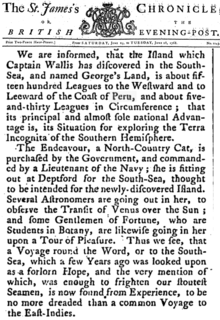
The Royal Society suggested command be given to Scottish geographer Alexander Dalrymple, who had urged that an expedition be sent to make contact with the estimated 50 million inhabitants of the Southern Continent with whom, he said, there was "at present no trade from Europe thither, though the scraps from this table would be sufficient to maintain the power, dominion, and sovereignty of Britain, by employing all its manufacturers and ships".[6] As a condition of his acceptance, Dalrymple demanded a brevet commission as a captain in the Royal Navy. However, First Lord of the Admiralty Edward Hawke refused, going so far as to say he would rather cut off his right hand than give command of a Navy vessel to someone not educated as a seaman.[7] In refusing Dalrymple's command, Hawke was influenced by previous insubordination aboard the sloop HMS Paramour in 1698, when naval officers had refused to take orders from civilian commander Dr. Edmond Halley.[7] The impasse was broken when the Admiralty proposed James Cook, a naval officer with a background in mathematics and cartography.[8] Acceptable to both parties, Cook was promoted to Lieutenant and named as commander of the expedition.[9]
Preparations and personnel
Vessel and provisions

The vessel chosen by the Admiralty for the voyage was a merchant collier named Earl of Pembroke, launched in June 1764 from the coal and whaling port of Whitby in North Yorkshire.[10] She was ship-rigged and sturdily built with a broad, flat bow, a square stern and a long box-like body with a deep hold.[11] A flat-bottomed design made her well-suited to sailing in shallow waters and allowed her to be beached for loading and unloading of cargo and for basic repairs without requiring a dry dock. Her length was 106 feet (32 m), with a beam of 29 feet 3 inches (8.92 m), and measuring 36871⁄94 tons burthen[10][12]
Earl of Pembroke was purchased by the Admiralty in May 1768 for £2,840 10s 11d[13][a] and sailed to Deptford on the River Thames to be prepared for the voyage. Her hull was sheathed and caulked, and a third internal deck installed to provide cabins, a powder magazine and storerooms.[14] A longboat, pinnace and yawl were provided as ship's boats, as well as a set of 28 ft (8.5 m) sweeps to allow the ship to be rowed if becalmed or demasted.[15] After commissioning into the Royal Navy as His Majesty's Bark the Endeavour, the ship was supplied with ten 4-pounder cannons and twelve swivel guns, for defence against native attack while in the Pacific.[16]
Provisions loaded at the outset of the voyage included 6,000 pieces of pork and 4,000 of beef, nine tons of bread, five tons of flour, three tons of sauerkraut, one ton of raisins and sundry quantities of cheese, salt, peas, oil, sugar and oatmeal. Alcohol supplies consisted of 250 barrels of beer, 44 barrels of brandy and 17 barrels of rum.[17]
Instructions
The Admiralty's Instructions to Cook were divided into two sections, both marked "Secret"[18] The first document dealt with the voyage to Tahiti, while the second dealt with the post-transit agenda. After Tahiti, Cook was instructed to sail directly south in search of the long-imagined sixth continent, referred to as the 'Southern Continent'. Next, he was to turn west to New Zealand, from where he was free to choose his homeward route. The Admiralty's Instructions do not mention the half-mapped fifth continent of New Holland (as Australia was known in the eighteenth century).[19]
Ship's company
On 30 July 1768 the Admiralty authorised a ship's company for the voyage, of 73 sailors and 12 Royal Marines.[20] The voyage was commanded by 40-year-old Lieutenant James Cook. His second lieutenant was Zachary Hicks, a 29-year-old from Stepney with experience as acting commander of the Hornet, a 16-gun cutter.[21] The third lieutenant was John Gore, a 16-year Naval veteran who had served as master's mate aboard HMS Dolphin during its circumnavigation of the world in 1766.[22]
Other notable people on the expedition include the official astronomer, Charles Green, then assistant to the Astronomer Royal, Nevil Maskelyne. Joseph Banks had been appointed to the voyage as the official botanist. Banks funded seven others to join him: a Swedish naturalist Daniel Solander, a Finnish naturalist Herman Spöring, two artists, a scientific secretary, and two black servants from his estate.[23]
Voyage of discovery
%2C_f.11_-_BL_Add_MS_23920.jpg)
Cook departed from Plymouth on 26 August 1768, carrying 94 people and 18 months of provisions.[24] On 15 November, Endeavour reached Rio de Janeiro and stayed there until 2 December, re-provisioning and making repairs. The Viceroy, the Marques de Azambuja, had been warned by his home government that Britain was seeking to extend its overseas power and influence following its victory in the Seven Years' War, and therefore suspected that the observation of the transit of Venus and study of natural history that Cook told him were the aims of his voyage were not its only or main objectives. Cook took offence at the Viceroy's suspicious attitude.[25] In his journal, he described Guanabara Bay, including its defensive fortifications, and noted that the city could be taken by a force of six ships of the line.[26] The ship rounded Cape Horn and continued westward across the Pacific to arrive at Matavai Bay, Tahiti on 13 April 1769, where the observations were to be made. The transit was scheduled to occur on 3 June, and in the meantime he commissioned the building of a small fort and observatory at what is now known as Point Venus.
The astronomer appointed to the task was Charles Green, assistant to the recently appointed Astronomer Royal, Nevil Maskelyne. The primary purpose of the observation was to obtain measurements that could be used to calculate more accurately the distance of Venus from the Sun. If this could be achieved, then the distances of the other planets could be worked out, based on their orbits. On the day of the transit observation, Cook recorded:
Saturday 3rd This day prov'd as favourable to our purpose as we could wish, not a Clowd was to be seen the Whole day and the Air was perfectly clear, so that we had every advantage we could desire in Observing the whole of the passage of the Planet Venus over the Suns disk: we very distinctly saw an Atmosphere or dusky shade round the body of the Planet which very much disturbed the times of the contacts particularly the two internal ones. D r Solander observed as well as Mr Green and my self, and we differ'd from one another in observeing the times of the Contacts much more than could be expected.[27]
Disappointingly, the separate measurements of Green, Cook and Solander varied by more than the anticipated margin of error. Their instrumentation was adequate by the standards of the time, but the resolution still could not eliminate the errors. When their results were later compared to those of the other observations of the same event made elsewhere for the exercise, the net result was not as conclusive or accurate as had been hoped. The difficulties are today thought to relate to the Black drop effect, an optical phenomenon that precludes accurate measurement – particularly with the instruments used by Cook, Green and Solander.
New Zealand
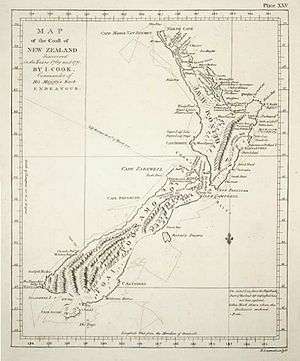

Once the observations were completed, Cook opened the sealed orders for the second part of his voyage: to search the south Pacific for signs of the postulated southern continent of Terra Australis, acting on additional instructions from the Admiralty.[28] The Royal Society, and especially Alexander Dalrymple, believed that Terra Australis must exist, and that Britain's best chance of discovering and claiming it before any rival European power would be by using Cook's innocuous Transit of Venus mission.
Cook, however, had his own personal doubts on the continent's existence. With the help of a Tahitian named Arioi and a navigator named Tupaia, who had extensive knowledge of Pacific geography, Cook reached New Zealand on 6 October 1769, leading only the second group of Europeans known to do so (after Abel Tasman over a century earlier, in 1642). Over the first two days of arriving on-shore, the first encounters with Māori resulted in the death of several locals. Cook and crew departed the region; Cook's journal entries reflect regret as he had failed his instructions to avoid hostilities with the indigenous people of any nations encountered.[29] Further Māori deaths occurred as Cook travelled North, the last occurring in Mercury Bay. No crew members of the Endeavour would die during their time in New Zealand.
The first amicable and refuelling landing for Cook and the crew took place in Tolaga Bay, and later in both Mercury Bay and the Bay of Islands over the first two months.[30] Cook and crew were hosted by local iwi (tribes) and hapū (subtribes) at their landing sites, and with exchange of taonga, goods, resources and knowledge; safe passage around the coastline was attributed to the mana (prestige) and distinction of Tupaia on board the Endeavour.[31] Christmas was spent off the coast of Northland, prior to navigating the West Coast of the North Island without landing onshore.[32] By mid-January, Cook arrived in Queen Charlotte Sound, a location he would favour in his second and third voyages. After two earlier attempts to plant the British flag, with permission of one rangatira (chief), Cook hoisted the flag in the name of Crown and Country that would have culturally shifting impact for Māori and the landscape of New Zealand.[33] The circumnavigation of the South Island was completed within two months. For the complete journey around both islands, relationships had been developed between Māori and the crew, the legacy of Tupaia recorded by Māori in oral histories in addition to thousands of specimens collected by the scientific expedition led by Joseph Banks and Cook mapping the complete coastline, making minor errors, such as calling Banks Peninsula an island.[34]
Cook Strait
On 22 January 1770, Cook climbed Kaitapeha peak on Arapawa Island and saw the strait (which he named Cook Strait) separating North and South Islands. This strait, which had been foreshadowed by Abel Tasman in 1642, proved that New Zealand was an archipelago and not part of the imagined Southern Continent.[35]
Foveaux Strait
Cook sighted Foveaux Strait during his circumnavigation of the South Island in March 1770 but, Margaret Cameron-Ash has argued, decided to hide it. The Admiralty had issued its usual instructions to hide strategically important discoveries that could become security risks, such as off-shore islands from which operations could be mounted by a hostile power, such as France. Consequently, Cook amended both his journal and chart to depict Stewart Island as a peninsula.[36]
Instructions fulfilled
He wrote in his Journal on 31 March 1770 that Endeavour's voyage "must be allowed to have set aside the most, if not all, the Arguments and proofs that have been advanced by different Authors to prove that there must be a Southern Continent; I mean to the Northward of 40 degrees South, for what may lie to the Southward of that Latitude I know not".[37]
On the same day he recorded his decision to set a course to return home by way of the yet unknown east coast of New Holland (as Australia was then called):
being now resolv'd [sic] to quit this Country altogether, and to bend my thought towards returning home by such a rout as might Conduce most to the Advantage of the Service I am upon, I consulted with the Officers upon the most Eligible way of putting this in Execution. To return by the way of Cape Horn was what I most wished, because by this rout we should have been able to prove the Existance [sic] or Non-Existance [sic] of a Southern Continent, which yet remains Doubtfull [sic]; but in order to Ascertain this we must have kept in a higher Latitude in the very Depth of Winter, but the Condition of the Ship, in every respect, was not thought sufficient for such an undertaking. For the same reason the thoughts of proceeding directly to the Cape of Good Hope was laid aside, especially as no discovery of any Moment could be hoped for in that rout. It was therefore resolved to return by way of the East Indies by the following rout: upon Leaving this Coast to steer to the Westward until we fall in with the East Coast of New Holland, and then to follow the direction of that Coast to the Northward, or what other direction it might take us, until we arrive at its Northern extremity; and if this should be found impracticable, then to Endeavour [sic] to fall in with the Land or Islands discovered by Quiros.[38]
A voyage to explore the east coast of New Holland, with a view to a British colonization of the country, had been recommended in John Campbell's editions of John Harris's Navigantium atque Itinerantium Bibliotheca, or Voyages and Travels (1744–1748, and 1764), a book which Cook had with him on Endeavour:
The first Point, with respect to a Discovery, would be, to send a small Squadron on the Coast of Van Diemen's Land, and from thence round, in the same course taken by Captain Tasman, by the Coast of New Guiney; which might enable the Nations that attempted it, to come to an absolute Certainty with regard to its Commodities and Commerce... By this means all the back Coast of New Holland, and New Guiney, might be roughly examined; and we might know as well, and as certainly, as the Dutch, how far a Colony settled there might answer our Expectations.[39]
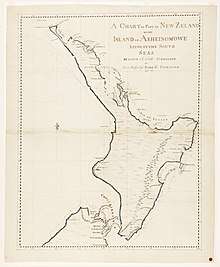 Manuscript nautical chart of the North Island of New Zealand, prepared during James Cook's first voyage, 1768–1771
Manuscript nautical chart of the North Island of New Zealand, prepared during James Cook's first voyage, 1768–1771 Manuscript nautical chart of the South Island of New Zealand prepared during James Cook's first voyage, 1768–1771
Manuscript nautical chart of the South Island of New Zealand prepared during James Cook's first voyage, 1768–1771
Australian coast
He then set course westwards, intending to strike for Van Diemen's Land (present-day Tasmania, sighted by Tasman) to establish whether or not it formed part of the fabled southern continent. However, they were forced to maintain a more northerly course owing to prevailing gales, and sailed on until 19 April 1770 when land was sighted at 6 a.m. The first land sighted near Present-day Point Hicks, was not, Cook's Point Hicks. Cook calculated that Van Diemen's Land ought to lie due south of their position, but having found the coastline trending to the south-west, recorded his doubt that this landmass was connected to it. This point was on the south-eastern coast of the Australian continent, and in doing so his expedition became the first recorded Europeans to have encountered its eastern coastline. In his journal, Cook recorded the event thus:
the Southermost Point of land we had in sight which bore from us W1/4S I judged to lay in the Latitude of 38°..0' S° and in the Longitude of 211°..07' W t from the Meridian of Greenwich. I have named it Point Hicks, because Lieut t Hicks was the first who discover'd this land.
The ship's log recorded that land was sighted at 6 a.m. on Thursday 19 April 1770. Cook's log used the nautical date, which, during the 18th century, assigned the same date to all ship's events from noon to noon, first p.m. and then a.m. That nautical date began twelve hours before the midnight beginning of the like-named civil date. Furthermore, Cook did not adjust his nautical date to account for circumnavigation of the globe until he had travelled a full 360° relative to the longitude of his home British port, either toward the east or west. Because he travelled west on his first voyage, this a.m. nautical date was the morning of a civil date 14 hours slow relative to his home port (port−14h). Because the south-east coast of Australia is now regarded as being 10 hours ahead relative to Britain, that date is now called Friday, 20 April.[40]
The landmark of this sighting is generally reckoned to be a point lying about half-way between the present-day towns of Orbost and Mallacoota on the south-eastern coast of the state of Victoria. A survey done in 1843 ignored or overlooked Cook's earlier naming of the point, giving it the name Cape Everard. On the 200th anniversary of the sighting, the name was officially changed back to Point Hicks.
Botany Bay
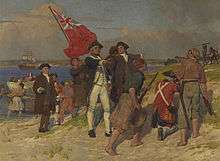
Endeavour continued northwards along the coastline, keeping the land in sight with Cook charting and naming landmarks as he went. A little over a week later, they came across an extensive but shallow inlet, and upon entering it moored off a low headland fronted by sand dunes. James Cook and crew made their first landing on the continent, at a place now known as Botany Bay, on Kurnell Peninsula and made contact of a hostile nature with the Gweagal Aborigines, on 29 April.[b] At first Cook bestowed the name "Sting-Ray Harbour"[41] to the inlet after the many such creatures found there; this was later changed to "Botanist Bay"[41] and finally Botany Bay after the unique specimens retrieved by the botanists Joseph Banks, Daniel Solander and Herman Spöring.
This first landing site was later to be promoted (particularly by Joseph Banks) as a suitable candidate for situating a settlement and British colonial outpost. However, almost 18 years later, when Captain Arthur Phillip and the First Fleet arrived in early 1788 to establish an outpost and penal colony, they found that the bay and surrounds did not live up to the promising picture that had been painted. Instead, Phillip gave orders to relocate to a harbour a few kilometres to the north, which Cook had named Port Jackson but had not further explored. It was in this harbour, at a place Phillip named Sydney Cove, that the settlement of Sydney was established. The settlement was for some time afterwards still referred to generally as Botany Bay. The expedition's scientific members commenced the first European scientific documentation of Australian fauna and flora.
At Cook's original landing contact was made with the local Australian Aboriginal inhabitants. As the ship sailed into the harbour, they noticed Aborigines on both of the headlands. At about 2 pm they put the anchor down near a group of six to eight huts. Two Aborigines, a younger and an older man, came down to the boat.[42] They did not accept the offer of gifts from Cook, whose lack of knowledge of Aboriginal custom may have prevented him from behaving acceptably in such exchanges. A musket was fired over their heads, which wounded the older man slightly, and he ran towards the huts. He came back with other men and threw spears at Cook's men, although they did no harm. They were chased off after two more rounds were fired.[42] The adults had left, but Cook found several Aboriginal children in the huts, and left some beads with them as a gesture of friendship.[42]
Port Jackson
On 6 May 1770, the Endeavour left Botany Bay and sailed north past an inlet "wherein there appeared to be safe anchorage". Cook named it Port Jackson, today generally known as Sydney Harbour.[43] No-one on the ship recorded seeing any of the Harbour's many islands, because their line of sight was blocked by the high promontories of South Head and Bradleys Head that shape its dog-leg entrance. However, these islands were possibly known to Captain Arthur Phillip, the First Fleet commander, before he departed England in 1787.[44]
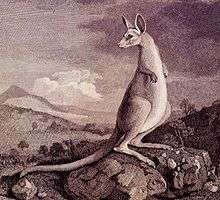
Seventeen Seventy
Cook continued northwards, charting along the coastline. He stopped at Bustard Bay (now known as Seventeen Seventy) at 8 o'clock on 23 May 1770 in 5 fathoms water on a sandy bottom at the South point of the Bay. Cook recounted that his clerk, Orton, had been molested while dead drunk that night, the perpetrators cutting off not only his clothes but also parts of his ears. Cook suspended and sent below the suspect Magra.[45] On 24 May Cook and Banks and others went ashore. He sounded the channel (now known as Round Hill Creek) and found a freshwater stream, noting there was room for a few ships to safely anchor. He noted a great deal of smoke on the hills and inspected one of the closest group of 10 fires around which were scattered cockle shells and other evidence of aboriginal occupation.[45]
Endeavour River
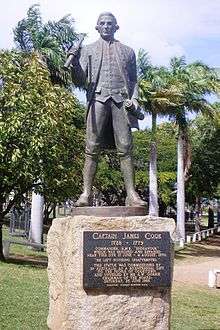
A mishap occurred when Endeavour ran aground on a shoal of the Great Barrier Reef, on 11 June 1770. The ship was seriously damaged and his voyage was delayed almost seven weeks while repairs were carried out on the beach (near the docks of modern Cooktown, at the mouth of the Endeavour River). While there, Joseph Banks, Herman Spöring and Daniel Solander made their first major collections of Australian flora.
The crew's encounters with the local Aboriginal people were mainly peaceable; from the group encountered here the name "kangaroo" entered the English language, coming from the local Guugu Yimidhirr word for a kind of grey kangaroo, gangurru (pronounced [ɡ̊aŋuru]).[46]
Possession Island
Once repairs were completed, the voyage continued and at about midday on 22 August 1770, Cook reached the northernmost tip of the coast. Without leaving the ship, he named it Cape York and departed the east coast. Turning west, he nursed the battered ship through the dangerously shallow waters of Torres Strait, earlier navigated by Luis Váez de Torres in 1606. Searching for a high vantage point, Cook saw a steep hill on a nearby island from the top of which he hoped to see "a passage into the Indian Seas". Cook named the island Possession Island, where he claimed the entire eastern coastline that he had just explored as British territory.[47]
In negotiating the Torres Strait past Cape York, Cook also put an end to the speculation that New Holland and New Guinea were part of the same land mass.[48]
Scurvy prevention
At that point in the voyage Cook had lost not a single man to scurvy, a remarkable and practically unheard-of achievement in 18th-century long-distance seafaring. Adhering to Royal Navy policy introduced in 1747, Cook persuaded his men to eat foods such as citrus fruits and sauerkraut. At that time it was known that poor diet caused scurvy but not specifically that a vitamin C deficiency was the culprit.
Sailors of the day were notoriously against innovation, and at first the men would not eat the sauerkraut. Cook used a "method I never once knew to fail with seamen."[49] He ordered it served to himself and the officers, and left an option for crew who wanted some. Within a week of seeing their superiors set a value on it the demand was so great a ration had to be instituted.[49] In other cases, however, Cook resorted to traditional naval discipline. "Punished Henry Stephens, Seaman, and Thomas Dunster, Marine, with twelve lashes each for refusing to take their allowance of fresh beef."[50]
Cook's general approach was essentially empirical, encouraging as broad a diet as circumstances permitted, and collecting such greens as could be had when making landfall. All onboard ate the same food, with Cook specifically dividing equally anything that could be divided (and indeed recommending that practice to any commander – journal 4 August 1770).
Two cases of scurvy did occur on board, astronomer Charles Green and a Tahiti navigator Tupaia were treated, but Cook was able to proudly record that upon reaching Batavia he had "not one man upon the sick list" (journal 15 October 1770), unlike so many voyages that reached that port with much of the crew suffering illness.
Homeward voyage
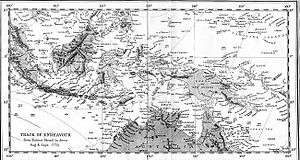
Endeavour then visited the island of Savu, staying for three days before continuing on to Batavia, the capital of the Dutch East Indies, to put in for repairs. Batavia was known for its outbreaks of malaria, and before they returned home in 1771 many in Cook's company succumbed to the disease and other ailments such as dysentery, including the Tahitian Tupaia, Banks' Finnish secretary and fellow scientist Herman Spöring, astronomer Charles Green, and the illustrator Sydney Parkinson. Cook named Spöring Island off the coast of New Zealand to honour Herman Spöring and his work on the voyage.
Cook then rounded the Cape of Good Hope and stopped at Saint Helena. On 10 July 1771 Nicholas Young, the boy who had first seen New Zealand, sighted England (specifically the Lizard) again for the first time, and Endeavour sailed up the English Channel, passing Beachy Head at 6 am on 12 July; that afternoon Endeavour anchored in the Downs, and Cook went ashore at Deal, Kent. His return was unexpected, as newspapers and journals had long since reported fears that Endeavour had been lost at sea or destroyed in combat against the French.[51]
Publication of journals
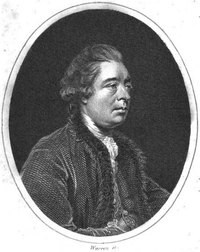
Cook's journals, along with those of Banks, were handed over to the Admiralty to be published upon his return. John Montagu, 4th Earl of Sandwich contracted, for £6,000, John Hawkesworth a literary critic, essayist, and editor of The Gentleman's Magazine to publish a comprehensive account of exploration in the Pacific: not just Cook's ventures but also those of Wallis, Byron and Carteret. Hawkesworth edited the journals of Byron, Wallis and Carteret into separate accounts as volume I and then blended Cook's and Joseph Banks' journals with some of his own sentiments and produced a single first-person narrative that appeared to be the words of Cook, as Volume II.[52] The book appeared in 1773 as three volumes with the title:
AN ACCOUNT OF THE VOYAGES undertaken by Order of His Present Majesty for making Discoveries in the Southern Hemisphere, and successively performed by Commodore Byron, Captain Wallis, Captain Carteret and Captain Cook, in the Dolphin, the Swallow and the Endeavour: Drawn up from the Journals which were kept by the several Commanders, and from the Papers of Joseph Banks, Esq.; by John Hawkesworth, LL.D. In three volumes. Illustrated with Cuts, and a great Variety of Charts and Maps relative to Countries now first discovered, or hitherto but imperfectly known.
— Printed for W. Strahan & T. Cadell in the Strand. London: MDCCLXXIII
The book went on sale on 9 June 1773 but widespread criticism in the press made the publication a personal disaster for Hawkesworth. Reviewers complained that the reader had no way to tell which part of the account was Cook, which part Banks and which part Hawkesworth and others were offended by the books' descriptions of the voyagers' sexual encounters with the Tahitians.[53][54] Cook was at sea again before the book was published and was later much disturbed by some of the sentiments that Hawkesworth has ascribed to him. He determined to edit his own journals in future.
Re-enactment
In 1970 Hans Hass shot the documentary television film Unsere Reise mit James Cook (Our Journey with James Cook), in which he retraced Cook's journey through the barrier reef using Cook's journal. Hass dived at various locations.
In 2001, the BBC set about making a documentary which involved a film crew, volunteers and historians retracing the voyage made by Captain Cook. One of the historians, Alexander Cook, documented the journey in his 2004 article "Sailing on The Ship: Re-enactment and the Quest for Popular History".[55]
In 1959, the Cooktown Re-enactment Association first performed a re-enactment of Cook's 1770 landing at the site of modern Cooktown, Australia, and have continued the tradition each year, with the support and participation of many of the local Guugu Yimithirr people. They celebrate the first act of reconciliation between Indigenous Australians and non-Indigenous people, based on a particular incident. Cook and his crew had developed a friendly relationship with the local people, recording more than 130 words of their language. However, after the crew refused to share 12 green turtles which they had caught, thus violating local customs, the locals became angry. A Guugu Yimithirr elder stepped in, presenting Cook with a broken-tipped spear as a peace offering, thus preventing an escalation which could have ended in bloodshed.[56][57]
See also
- Australian places named by James Cook
Notes
- ^[a] In today's terms, this equates to a valuation for Endeavour of approximately £265,000 and a purchase price of £326,400.[58]
- ^[b] This date does not need adjustment because it occurred during the afternoon (p.m.) on 29 April in the ship's log, but was the afternoon of the civil date of 28 April, 14 hours west of port, which is now a civil date 10 hours east of port, 24 hours later, hence a modern civil date of 29 April.
References
Citations
- Rigby & van der Merwe 2002, p. 24
- "Secret Instructions to Lieutenant Cook 30 July 1768 (UK)". National Library of Australia. 2005. Archived from the original on 21 July 2008. Retrieved 26 August 2008.
- Lloyd's Evening Post, 5 August, The St. James's Chronicle, 6 August, Courier du Bas-Rhin (Cleves), 20 August 1768.
- Also in Lloyd's Evening Post, 19 August and The New York Journal, 3 November 1768.
- The Boston Chronicle [Mass.], 12 September 1768.
- Alexander Dalrymple, An Historical Collection of the Several Voyages and Discoveries in the South Pacific Ocean, Vol.I, London, 1767 and 1770, pp. xxviii–xxix.
- A General History and Collection of Voyages and Travels, Vol. 12 at Project Gutenberg, editor Robert Kerr's introduction footnote 3
- McDermott, Peter Joseph (6 November 1878). "Pacific Exploration". The Brisbane Courier. Brisbane Newspaper Company Ltd. p. 5. Retrieved 27 August 2008.
- Rigby & van der Merwe 2002, p. 30
- McLintock, A.H., ed. (1966). "Ships, Famous". An Encyclopedia of New Zealand. Ministry for Culture and Heritage/Te Manatū Taonga, Government of New Zealand. Retrieved 5 May 2009.
- Hosty & Hundley 2003, p. 41
- Blainey 2008, p. 17
- Knight, C. (1933). "H.M. Bark Endeavour". Mariner's Mirror. United Kingdom: Nautical Research Guild. 19 (3): 292–302. doi:10.1080/00253359.1933.10655709.
- Hosty & Hundley 2003, p. 61
- Marquardt 1995, p. 18
- Marquardt 1995, p. 13
- Minutes of the Royal Navy Victualling Board, 15 June 1768, cited in Beaglehole 1968, p. 613
- Beaglehole, J.C. (1968). Cook Journals vol.1. Cambridge: Hakluyt Society. p. cclxxix. ISBN 0851157440.
- Cameron-Ash, M. (2018). Lying for the Admiralty. Rosenberg. p. 95. ISBN 9780648043966.
- Beaglehole 1968, p. 588
- Beaglehole 1968, p. cxxx
- Hough 1995, pp. 63–64
- Holmes, Richard (2009). The Age of Wonder. HarperPress., p. 10. Holmes incorrectly states that Green's first name was William, not Charles.
- Beaglehole 1968, p. 4
- Antonio Camillo de Oliveira, “Bicentenârio da Passâgem do Capitão Cook pelo Rio de Janeiro”, Revista do Instituto Histôrico e Geogrâfico Brasileiro, vol.290, Jan-Mar 1971, pp.93-120.
- James Cook, "Description of the Bay or River of Rio de Janeiro"; cited in Pedro da Cunha e Menezes e Júlio Bandeira, O Rio de Janeiro na Rota dos Mares do Sul, Rio de Janeiro, Brazil, 2004, p.44.
- "Cook's Journal: Daily Entries : 3 June 1769". National Library of Australia. Retrieved 26 August 2018.
- "Secret Instructions to Captain Cook, 30 June 1768" (PDF). National Archives of Australia. Retrieved 25 January 2007.
- Frame, William; Walker, Laura (31 May 2018). James Cook. MQUP. doi:10.2307/j.ctt201mpnk. ISBN 9780773554047.
- Gates, Richard (Historian), author. (2019). When Toawaka met Cook: stories of Te Whanganui o Hei - Mercury Bay. ISBN 9780473477875. OCLC 1104693847.CS1 maint: multiple names: authors list (link)
- "Uncharted With Sam Neill". Prime. Retrieved 24 October 2019.
- Banks, Joseph (1962). The Endeavour Journal of Joseph Banks: 1768–1771. vol. 2. Sydney: Angus & Robertson. p. 93. ISBN 9781406800517.
- "Cook's Journal: Daily Entries, 31 January 1770". southseas.nla.gov.au. South Seas. Retrieved 24 October 2019.
- "Voyage to Aotearoa - Exhibitions - Auckland War Memorial Museum". Retrieved 25 October 2019.
- Cameron-Ash, M. (2018). Lying for the Admiralty. Sydney: Rosenberg. p. 137. ISBN 9780648043966.
- Cameron-Ash, M. (2018). Lying for the Admiralty. Sydney: Rosenberg. pp. 139–145. ISBN 9780648043966.
- W.J.L. Wharton, Captain Cook's Journal During the First Voyage Round the World, London, 1893. See also J. C. Beaglehole and R. A. Skelton (eds.), The Journals of Captain James Cook on His Voyages of Discovery, Vol. 1, The Voyage of the Endeavor, 1768–1771, Cambridge University Press for the Hakluyt Society, 1955, p.290.
- W.J.L. Wharton, Captain Cook's Journal During the First Voyage Round the World, London, 1893. See also J. C. Beaglehole and R. A. Skelton (eds.), The Journals of Captain James Cook on His Voyages of Discovery, Vol. 1, The Voyage of the Endeavor, 1768–1771, Cambridge University Press for the Hakluyt Society, 1955, pp.272–273.
- John Harris, Navigantium atque Itinerantium Bibilotheca or A Complete Collection of Voyages and Travels, revised by John Campbell, London, 1764, p.332; cited in J. C. Beaglehole and R. A. Skelton (eds.), The Journals of Captain James Cook on His Voyages of Discovery, Vol. 1, The Voyage of the Endeavor, 1768–1771, Cambridge University Press and the Hakluyt Society, 1955, p.lxxvi.
- Arthur R. Hinks, "Nautical time and civil date", The Geographical Journal, 86 (1935) 153–157.
- "Cook's Journal: Daily Entries, 6 May 1770". Retrieved 26 November 2012.
- "Cook's Journal: Daily Entries, 29 April 1770". southseas.nla.gov.au. South Seas. Retrieved 25 October 2019.
- Beaglehole (1968), pp 312-13
- Phillip, Arthur (11 April 1787). Comments on a draft of his instructions. TNA CO 201/2, f.128-131.
- "Cook's Journal: Daily Entries, 22 May 1770". southseas.nla.gov.au. South Seas. Retrieved 13 December 2017.
- Robson 2004, p. 81
- Cook, James, Journal of the HMS Endeavour, 1768-1771, National Library of Australia, Manuscripts Collection, MS 1, 22 August 1770
- G. Williams (2002)
- Beaglehole 1968, p. 74
- Wilcox, Ten Who Dared at 97 (Boston: Little, Brown & Co. 1977).
- Beaglehole 1968, p. clxvi
- Villiers 1967, p. 151
- Ravneberg, Ronald L. "The Hawkesworth Copy" (PDF). Retrieved 9 October 2011.
- Salmond, Anne (2009). Aphrodite's Island: The European Discovery of Tahiti. University of California Press.
- Cook, Alexander (Spring 2004). "Sailing on the Ship: Re-enactment and the Quest for Popular History". History Workshop Journal (57): 247–255.
- Kim, Sharnie; Stephen, Adam (19 June 2020). "Cooktown's Indigenous people help commemorate 250 years since Captain Cook's landing with re-enactment". ABC News. Australian Broadcasting Corporation. Retrieved 6 July 2020.
- Banks, Joseph (19 July 1770). "Banks's Journal: Daily Entries". National Library of Australia. Retrieved 8 July 2020.
- "Purchasing Power of British Pounds from 1264 to Present". MeasuringWorth. 2009. Retrieved 5 August 2009.
Sources
- Beaglehole, J.C., ed. (1968). The Journals of Captain James Cook on His Voyages of Discovery, vol. I: The Voyage of the Endeavour 1768–1771. Cambridge University Press. OCLC 223185477.CS1 maint: ref=harv (link)
- Blainey, Geoffrey (2008). Sea of Dangers: Captain Cook and his rivals. Penguin Group (Australia). ISBN 978-0-670-07223-1.CS1 maint: ref=harv (link)
- Cameron-Ash, Margaret (2018). Lying for the Admiralty: Captain Cook's Endeavour Voyage. Rosenberg Publishing. ISBN 978-0-6480-4396-6.
- Hawkesworth, John; Byron, John; Wallis, Samuel; Carteret, Philip; Cook, James; Banks, Joseph (1773), An account of the voyages undertaken by the order of His present Majesty for making discoveries in the Southern Hemisphere, and successively performed by Commodore Byron, Captain Wallis, Captain Carteret, and Captain Cook, in the Dolphin, the Swallow, and the Endeavour drawn up from the journals which were kept by the several commanders, and from the papers of Joseph Banks, esq, London Printed for W. Strahan and T. Cadell, Volume I, Volume II-III
- Hosty, Kieran; Hundley, Paul (June 2003). "Preliminary Report on the Australian National Maritime Museum's participation in the Rhode Island Marine Archaeology Project's search for HMB Endeavour" (PDF). Australian National Maritime Museum. Archived from the original (PDF) on 6 July 2009. Retrieved 22 July 2009. Cite journal requires
|journal=(help)CS1 maint: ref=harv (link) - Hough, Richard (1995). Captain James Cook. Hodder and Stoughton. ISBN 0-340-82556-1.CS1 maint: ref=harv (link)
- Marquardt, K H (1995). Captain Cook's Endeavour. Naval Institute Press. ISBN 1-55750-118-1.CS1 maint: ref=harv (link)
- Parkin, Ray (2003). H. M. Bark Endeavour. Miegunyah Press. ISBN 0-522-85093-6.CS1 maint: ref=harv (link)
- Rigby, Nigel; van der Merwe, Pieter (2002). Captain Cook in the Pacific. National Maritime Museum (UK). ISBN 0-948065-43-5.CS1 maint: ref=harv (link)
- Robson, John (2004). The Captain Cook Encyclopædia. Milsons Point, NSW: Random House Australia. ISBN 0-7593-1011-4.CS1 maint: ref=harv (link)
- Villiers, Alan (1967). Captain Cook. The Seamans Seaman. London: Penguin Books. ISBN 0-14-139062-X.CS1 maint: ref=harv (link)
External links
- The Endeavour journal (1) and The Endeavour journal (2), as kept by James Cook – digitised and held by the National Library of Australia
- The South Seas Project: maps and online editions of the Journals of James Cook's First Pacific Voyage. 1768–1771, Includes full text of journals kept by Cook, Joseph Banks and Sydney Parkinson, as well as the complete text of John Hawkesworth's 1773 Account of Cook's first voyage.
- The Endeavour Replica A replica of Captain Cook's vessel.
- Cook's First Voyage Website of illustrations and maps about Cook's first voyage.
- Captain Cook Society
